| Listing 1 - 10 of 16 | << page >> |
Sort by
|
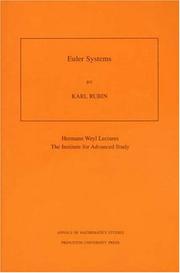
ISBN: 0691050759 1400865204 9781400865208 0691050767 9780691050768 9780691050751 9780691050768 Year: 2014 Publisher: Princeton, NJ
Abstract | Keywords | Export | Availability | Bookmark
 Loading...
Loading...Choose an application
- Reference Manager
- EndNote
- RefWorks (Direct export to RefWorks)
One of the most exciting new subjects in Algebraic Number Theory and Arithmetic Algebraic Geometry is the theory of Euler systems. Euler systems are special collections of cohomology classes attached to p-adic Galois representations. Introduced by Victor Kolyvagin in the late 1980's in order to bound Selmer groups attached to p-adic representations, Euler systems have since been used to solve several key problems. These include certain cases of the Birch and Swinnerton-Dyer Conjecture and the Main Conjecture of Iwasawa Theory. Because Selmer groups play a central role in Arithmetic Algebraic Geometry, Euler systems should be a powerful tool in the future development of the field. Here, in the first book to appear on the subject, Karl Rubin presents a self-contained development of the theory of Euler systems. Rubin first reviews and develops the necessary facts from Galois cohomology. He then introduces Euler systems, states the main theorems, and develops examples and applications. The remainder of the book is devoted to the proofs of the main theorems as well as some further speculations. The book assumes a solid background in algebraic Number Theory, and is suitable as an advanced graduate text. As a research monograph it will also prove useful to number theorists and researchers in Arithmetic Algebraic Geometry.
Algebraic number theory. --- p-adic numbers. --- Numbers, p-adic --- Number theory --- p-adic analysis --- Galois cohomology --- Cohomologie galoisienne. --- Algebraic number theory --- p-adic numbers --- Abelian extension. --- Abelian variety. --- Absolute Galois group. --- Algebraic closure. --- Barry Mazur. --- Big O notation. --- Birch and Swinnerton-Dyer conjecture. --- Cardinality. --- Class field theory. --- Coefficient. --- Cohomology. --- Complex multiplication. --- Conjecture. --- Corollary. --- Cyclotomic field. --- Dimension (vector space). --- Divisibility rule. --- Eigenvalues and eigenvectors. --- Elliptic curve. --- Error term. --- Euler product. --- Euler system. --- Exact sequence. --- Existential quantification. --- Field of fractions. --- Finite set. --- Functional equation. --- Galois cohomology. --- Galois group. --- Galois module. --- Gauss sum. --- Global field. --- Heegner point. --- Ideal class group. --- Integer. --- Inverse limit. --- Inverse system. --- Karl Rubin. --- Local field. --- Mathematical induction. --- Maximal ideal. --- Modular curve. --- Modular elliptic curve. --- Natural number. --- Orthogonality. --- P-adic number. --- Pairing. --- Principal ideal. --- R-factor (crystallography). --- Ralph Greenberg. --- Remainder. --- Residue field. --- Ring of integers. --- Scientific notation. --- Selmer group. --- Subgroup. --- Tate module. --- Taylor series. --- Tensor product. --- Theorem. --- Upper and lower bounds. --- Victor Kolyvagin. --- Courbes elliptiques --- Nombres, Théorie des
Book
ISBN: 1282458000 1282936328 9786612936326 9786612458002 1400835399 9781400835393 9780691142920 0691142920 0691142939 9780691142937 Year: 2010 Publisher: Princeton, NJ
Abstract | Keywords | Export | Availability | Bookmark
 Loading...
Loading...Choose an application
- Reference Manager
- EndNote
- RefWorks (Direct export to RefWorks)
This book studies the intersection cohomology of the Shimura varieties associated to unitary groups of any rank over Q. In general, these varieties are not compact. The intersection cohomology of the Shimura variety associated to a reductive group G carries commuting actions of the absolute Galois group of the reflex field and of the group G(Af) of finite adelic points of G. The second action can be studied on the set of complex points of the Shimura variety. In this book, Sophie Morel identifies the Galois action--at good places--on the G(Af)-isotypical components of the cohomology. Morel uses the method developed by Langlands, Ihara, and Kottwitz, which is to compare the Grothendieck-Lefschetz fixed point formula and the Arthur-Selberg trace formula. The first problem, that of applying the fixed point formula to the intersection cohomology, is geometric in nature and is the object of the first chapter, which builds on Morel's previous work. She then turns to the group-theoretical problem of comparing these results with the trace formula, when G is a unitary group over Q. Applications are then given. In particular, the Galois representation on a G(Af)-isotypical component of the cohomology is identified at almost all places, modulo a non-explicit multiplicity. Morel also gives some results on base change from unitary groups to general linear groups.
Shimura varieties. --- Homology theory. --- Cohomology theory --- Contrahomology theory --- Algebraic topology --- Varieties, Shimura --- Arithmetical algebraic geometry --- Accuracy and precision. --- Adjoint. --- Algebraic closure. --- Archimedean property. --- Automorphism. --- Base change map. --- Base change. --- Calculation. --- Clay Mathematics Institute. --- Coefficient. --- Compact element. --- Compact space. --- Comparison theorem. --- Conjecture. --- Connected space. --- Connectedness. --- Constant term. --- Corollary. --- Duality (mathematics). --- Existential quantification. --- Exterior algebra. --- Finite field. --- Finite set. --- Fundamental lemma (Langlands program). --- Galois group. --- General linear group. --- Haar measure. --- Hecke algebra. --- Homomorphism. --- L-function. --- Logarithm. --- Mathematical induction. --- Mathematician. --- Maximal compact subgroup. --- Maximal ideal. --- Morphism. --- Neighbourhood (mathematics). --- Open set. --- Parabolic induction. --- Permutation. --- Prime number. --- Ramanujan–Petersson conjecture. --- Reductive group. --- Ring (mathematics). --- Scientific notation. --- Shimura variety. --- Simply connected space. --- Special case. --- Sub"ient. --- Subalgebra. --- Subgroup. --- Symplectic group. --- Theorem. --- Trace formula. --- Unitary group. --- Weyl group.
Book
ISBN: 1280494654 9786613589880 1400842735 9781400842735 9780691154244 0691154244 9780691154251 0691154252 Year: 2012 Volume: 183 Publisher: Princeton, NJ
Abstract | Keywords | Export | Availability | Bookmark
 Loading...
Loading...Choose an application
- Reference Manager
- EndNote
- RefWorks (Direct export to RefWorks)
Mumford-Tate groups are the fundamental symmetry groups of Hodge theory, a subject which rests at the center of contemporary complex algebraic geometry. This book is the first comprehensive exploration of Mumford-Tate groups and domains. Containing basic theory and a wealth of new views and results, it will become an essential resource for graduate students and researchers. Although Mumford-Tate groups can be defined for general structures, their theory and use to date has mainly been in the classical case of abelian varieties. While the book does examine this area, it focuses on the nonclassical case. The general theory turns out to be very rich, such as in the unexpected connections of finite dimensional and infinite dimensional representation theory of real, semisimple Lie groups. The authors give the complete classification of Hodge representations, a topic that should become a standard in the finite-dimensional representation theory of noncompact, real, semisimple Lie groups. They also indicate that in the future, a connection seems ready to be made between Lie groups that admit discrete series representations and the study of automorphic cohomology on "ients of Mumford-Tate domains by arithmetic groups. Bringing together complex geometry, representation theory, and arithmetic, this book opens up a fresh perspective on an important subject.
Mumford-Tate groups. --- Geometry, Algebraic. --- Algebraic geometry --- Geometry --- Hodge theory --- Mumford-Tate groups --- Deligne torus integer. --- Galois group. --- Grothendieck conjecture. --- Hodge decomposition. --- Hodge domain. --- Hodge filtration. --- Hodge orientation. --- Hodge representation. --- Hodge structure. --- Hodge tensor. --- Hodge theory. --- Kubota rank. --- Lie algebra representation. --- Lie group. --- Mumford-Tate domain. --- Mumford-Tate group. --- Mumford-Tate subdomain. --- Noether-Lefschetz locus. --- Vogan diagram method. --- Weyl group. --- abelian variety. --- absolute Hodge class. --- algebraic geometry. --- arithmetic group. --- automorphic cohomology. --- classical group. --- compact dual. --- complex manifold. --- complex multiplication Hodge structure. --- complex multiplication. --- endomorphism algebra. --- exceptional group. --- holomorphic mapping. --- homogeneous complex manifold. --- homomorphism. --- mixed Hodge structure. --- moduli space. --- monodromy group. --- natural symmetry group. --- oriented imaginary number fields. --- period domain. --- period map. --- polarization. --- polarized Hodge structure. --- pure Hodge structure. --- reflex field. --- semisimple Lie algebra. --- semisimple Lie group. --- Γ-equivalence classes.
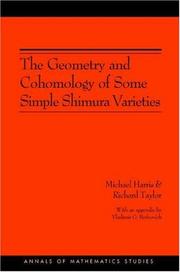
ISBN: 1400837200 9781400837205 0691090920 9780691090924 Year: 2001 Publisher: Princeton, NJ
Abstract | Keywords | Export | Availability | Bookmark
 Loading...
Loading...Choose an application
- Reference Manager
- EndNote
- RefWorks (Direct export to RefWorks)
This book aims first to prove the local Langlands conjecture for GLn over a p-adic field and, second, to identify the action of the decomposition group at a prime of bad reduction on the l-adic cohomology of the "simple" Shimura varieties. These two problems go hand in hand. The results represent a major advance in algebraic number theory, finally proving the conjecture first proposed in Langlands's 1969 Washington lecture as a non-abelian generalization of local class field theory. The local Langlands conjecture for GLn(K), where K is a p-adic field, asserts the existence of a correspondence, with certain formal properties, relating n-dimensional representations of the Galois group of K with the representation theory of the locally compact group GLn(K). This book constructs a candidate for such a local Langlands correspondence on the vanishing cycles attached to the bad reduction over the integer ring of K of a certain family of Shimura varieties. And it proves that this is roughly compatible with the global Galois correspondence realized on the cohomology of the same Shimura varieties. The local Langlands conjecture is obtained as a corollary. Certain techniques developed in this book should extend to more general Shimura varieties, providing new instances of the local Langlands conjecture. Moreover, the geometry of the special fibers is strictly analogous to that of Shimura curves and can be expected to have applications to a variety of questions in number theory.
Mathematics --- Shimura varieties. --- MATHEMATICS / Number Theory. --- Varieties, Shimura --- Arithmetical algebraic geometry --- Math --- Science --- Abelian variety. --- Absolute value. --- Algebraic group. --- Algebraically closed field. --- Artinian. --- Automorphic form. --- Base change. --- Bijection. --- Canonical map. --- Codimension. --- Coefficient. --- Cohomology. --- Compactification (mathematics). --- Conjecture. --- Corollary. --- Dimension (vector space). --- Dimension. --- Direct limit. --- Division algebra. --- Eigenvalues and eigenvectors. --- Elliptic curve. --- Embedding. --- Equivalence class. --- Equivalence of categories. --- Existence theorem. --- Field of fractions. --- Finite field. --- Function field. --- Functor. --- Galois cohomology. --- Galois group. --- Generic point. --- Geometry. --- Hasse invariant. --- Infinitesimal character. --- Integer. --- Inverse system. --- Isomorphism class. --- Lie algebra. --- Local class field theory. --- Maximal torus. --- Modular curve. --- Moduli space. --- Monic polynomial. --- P-adic number. --- Prime number. --- Profinite group. --- Residue field. --- Ring of integers. --- Separable extension. --- Sheaf (mathematics). --- Shimura variety. --- Simple group. --- Special case. --- Spectral sequence. --- Square root. --- Subset. --- Tate module. --- Theorem. --- Transcendence degree. --- Unitary group. --- Valuative criterion. --- Variable (mathematics). --- Vector space. --- Weil group. --- Weil pairing. --- Zariski topology.
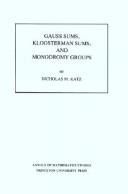
ISBN: 0691084335 0691084327 1400882125 Year: 1988 Volume: vol 116 Publisher: Princeton, N.J. Princeton University
Abstract | Keywords | Export | Availability | Bookmark
 Loading...
Loading...Choose an application
- Reference Manager
- EndNote
- RefWorks (Direct export to RefWorks)
The study of exponential sums over finite fields, begun by Gauss nearly two centuries ago, has been completely transformed in recent years by advances in algebraic geometry, culminating in Deligne's work on the Weil Conjectures. It now appears as a very attractive mixture of algebraic geometry, representation theory, and the sheaf-theoretic incarnations of such standard constructions of classical analysis as convolution and Fourier transform. The book is simultaneously an account of some of these ideas, techniques, and results, and an account of their application to concrete equidistribution questions concerning Kloosterman sums and Gauss sums.
Group theory --- Algebraic geometry --- Number theory --- 511.33 --- Analytical and multiplicative number theory. Asymptotics. Sieves etc. --- 511.33 Analytical and multiplicative number theory. Asymptotics. Sieves etc. --- Gaussian sums --- Homology theory --- Kloosterman sums --- Monodromy groups --- Kloostermann sums --- Sums, Kloosterman --- Sums, Kloostermann --- Exponential sums --- Cohomology theory --- Contrahomology theory --- Algebraic topology --- Gauss sums --- Sums, Gaussian --- Analytical and multiplicative number theory. Asymptotics. Sieves etc --- Gaussian sums. --- Kloosterman sums. --- Homology theory. --- Monodromy groups. --- Number theory. --- Nombres, Théorie des. --- Exponential sums. --- Sommes exponentielles. --- Arithmetic --- Arithmétique --- Geometry, Algebraic. --- Géométrie algébrique --- Abelian category. --- Absolute Galois group. --- Absolute value. --- Additive group. --- Adjoint representation. --- Affine variety. --- Algebraic group. --- Automorphic form. --- Automorphism. --- Big O notation. --- Cartan subalgebra. --- Characteristic polynomial. --- Classification theorem. --- Coefficient. --- Cohomology. --- Cokernel. --- Combination. --- Commutator. --- Compactification (mathematics). --- Complex Lie group. --- Complex number. --- Conjugacy class. --- Continuous function. --- Convolution theorem. --- Convolution. --- Determinant. --- Diagonal matrix. --- Dimension (vector space). --- Direct sum. --- Dual basis. --- Eigenvalues and eigenvectors. --- Empty set. --- Endomorphism. --- Equidistribution theorem. --- Estimation. --- Exactness. --- Existential quantification. --- Exponential sum. --- Exterior algebra. --- Faithful representation. --- Finite field. --- Finite group. --- Four-dimensional space. --- Frobenius endomorphism. --- Fundamental group. --- Fundamental representation. --- Galois group. --- Gauss sum. --- Homomorphism. --- Integer. --- Irreducibility (mathematics). --- Isomorphism class. --- Kloosterman sum. --- L-function. --- Leray spectral sequence. --- Lie algebra. --- Lie theory. --- Maximal compact subgroup. --- Method of moments (statistics). --- Monodromy theorem. --- Monodromy. --- Morphism. --- Multiplicative group. --- Natural number. --- Nilpotent. --- Open problem. --- P-group. --- Pairing. --- Parameter space. --- Parameter. --- Partially ordered set. --- Perfect field. --- Point at infinity. --- Polynomial ring. --- Prime number. --- Quotient group. --- Representation ring. --- Representation theory. --- Residue field. --- Riemann hypothesis. --- Root of unity. --- Sheaf (mathematics). --- Simple Lie group. --- Skew-symmetric matrix. --- Smooth morphism. --- Special case. --- Spin representation. --- Subgroup. --- Support (mathematics). --- Symmetric matrix. --- Symplectic group. --- Symplectic vector space. --- Tensor product. --- Theorem. --- Trace (linear algebra). --- Trivial representation. --- Variable (mathematics). --- Weil conjectures. --- Weyl character formula. --- Zariski topology.
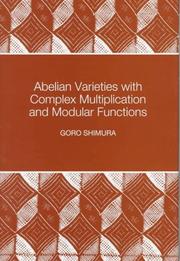
ISBN: 0691016569 1400883946 9780691016566 Year: 1998 Volume: 46 Publisher: Princeton, N.J. Princeton University Press
Abstract | Keywords | Export | Availability | Bookmark
 Loading...
Loading...Choose an application
- Reference Manager
- EndNote
- RefWorks (Direct export to RefWorks)
Reciprocity laws of various kinds play a central role in number theory. In the easiest case, one obtains a transparent formulation by means of roots of unity, which are special values of exponential functions. A similar theory can be developed for special values of elliptic or elliptic modular functions, and is called complex multiplication of such functions. In 1900 Hilbert proposed the generalization of these as the twelfth of his famous problems. In this book, Goro Shimura provides the most comprehensive generalizations of this type by stating several reciprocity laws in terms of abelian varieties, theta functions, and modular functions of several variables, including Siegel modular functions. This subject is closely connected with the zeta function of an abelian variety, which is also covered as a main theme in the book. The third topic explored by Shimura is the various algebraic relations among the periods of abelian integrals. The investigation of such algebraicity is relatively new, but has attracted the interest of increasingly many researchers. Many of the topics discussed in this book have not been covered before. In particular, this is the first book in which the topics of various algebraic relations among the periods of abelian integrals, as well as the special values of theta and Siegel modular functions, are treated extensively.
Ordered algebraic structures --- 512.74 --- Abelian varieties --- Modular functions --- Functions, Modular --- Elliptic functions --- Group theory --- Number theory --- Varieties, Abelian --- Geometry, Algebraic --- Algebraic groups. Abelian varieties --- 512.74 Algebraic groups. Abelian varieties --- Abelian varieties. --- Modular functions. --- Abelian extension. --- Abelian group. --- Abelian variety. --- Absolute value. --- Adele ring. --- Affine space. --- Affine variety. --- Algebraic closure. --- Algebraic equation. --- Algebraic extension. --- Algebraic number field. --- Algebraic structure. --- Algebraic variety. --- Analytic manifold. --- Automorphic function. --- Automorphism. --- Big O notation. --- CM-field. --- Characteristic polynomial. --- Class field theory. --- Coefficient. --- Complete variety. --- Complex conjugate. --- Complex multiplication. --- Complex number. --- Complex torus. --- Corollary. --- Degenerate bilinear form. --- Differential form. --- Direct product. --- Direct proof. --- Discrete valuation ring. --- Divisor. --- Eigenvalues and eigenvectors. --- Embedding. --- Endomorphism. --- Existential quantification. --- Field of fractions. --- Finite field. --- Fractional ideal. --- Function (mathematics). --- Fundamental theorem. --- Galois extension. --- Galois group. --- Galois theory. --- Generic point. --- Ground field. --- Group theory. --- Groupoid. --- Hecke character. --- Homology (mathematics). --- Homomorphism. --- Identity element. --- Integer. --- Irreducibility (mathematics). --- Irreducible representation. --- Lie group. --- Linear combination. --- Linear subspace. --- Local ring. --- Modular form. --- Natural number. --- Number theory. --- Polynomial. --- Prime factor. --- Prime ideal. --- Projective space. --- Projective variety. --- Rational function. --- Rational mapping. --- Rational number. --- Real number. --- Residue field. --- Riemann hypothesis. --- Root of unity. --- Scientific notation. --- Semisimple algebra. --- Simple algebra. --- Singular value. --- Special case. --- Subgroup. --- Subring. --- Subset. --- Summation. --- Theorem. --- Vector space. --- Zero element.
Book
ISBN: 0691036810 0691036756 1400882540 9780691036755 9780691036816 Year: 1994 Volume: 133 Publisher: Princeton (N.J.): Princeton university press,
Abstract | Keywords | Export | Availability | Bookmark
 Loading...
Loading...Choose an application
- Reference Manager
- EndNote
- RefWorks (Direct export to RefWorks)
Written for advanced undergraduate and first-year graduate students, this book aims to introduce students to a serious level of p-adic analysis with important implications for number theory. The main object is the study of G-series, that is, power series y=aij=0 Ajxj with coefficients in an algebraic number field K. These series satisfy a linear differential equation Ly=0 with LIK(x) [d/dx] and have non-zero radii of convergence for each imbedding of K into the complex numbers. They have the further property that the common denominators of the first s coefficients go to infinity geometrically with the index s. After presenting a review of valuation theory and elementary p-adic analysis together with an application to the congruence zeta function, this book offers a detailed study of the p-adic properties of formal power series solutions of linear differential equations. In particular, the p-adic radii of convergence and the p-adic growth of coefficients are studied. Recent work of Christol, Bombieri, André, and Dwork is treated and augmented. The book concludes with Chudnovsky's theorem: the analytic continuation of a G -series is again a G -series. This book will be indispensable for those wishing to study the work of Bombieri and André on global relations and for the study of the arithmetic properties of solutions of ordinary differential equations.
Analyse p-adique --- H-fonction --- H-functie --- H-function --- p-adic analyse --- p-adic analysis --- H-functions --- H-functions. --- p-adic analysis. --- Analysis, p-adic --- Algebra --- Calculus --- Geometry, Algebraic --- Fox's H-function --- G-functions, Generalized --- Generalized G-functions --- Generalized Mellin-Barnes functions --- Mellin-Barnes functions, Generalized --- Hypergeometric functions --- Adjoint. --- Algebraic Method. --- Algebraic closure. --- Algebraic number field. --- Algebraic number theory. --- Algebraic variety. --- Algebraically closed field. --- Analytic continuation. --- Analytic function. --- Argument principle. --- Arithmetic. --- Automorphism. --- Bearing (navigation). --- Binomial series. --- Calculation. --- Cardinality. --- Cartesian coordinate system. --- Cauchy sequence. --- Cauchy's theorem (geometry). --- Coefficient. --- Cohomology. --- Commutative ring. --- Complete intersection. --- Complex analysis. --- Conjecture. --- Density theorem. --- Differential equation. --- Dimension (vector space). --- Direct sum. --- Discrete valuation. --- Eigenvalues and eigenvectors. --- Elliptic curve. --- Equation. --- Equivalence class. --- Estimation. --- Existential quantification. --- Exponential function. --- Exterior algebra. --- Field of fractions. --- Finite field. --- Formal power series. --- Fuchs' theorem. --- G-module. --- Galois extension. --- Galois group. --- General linear group. --- Generic point. --- Geometry. --- Hypergeometric function. --- Identity matrix. --- Inequality (mathematics). --- Intercept method. --- Irreducible element. --- Irreducible polynomial. --- Laurent series. --- Limit of a sequence. --- Linear differential equation. --- Lowest common denominator. --- Mathematical induction. --- Meromorphic function. --- Modular arithmetic. --- Module (mathematics). --- Monodromy. --- Monotonic function. --- Multiplicative group. --- Natural number. --- Newton polygon. --- Number theory. --- P-adic number. --- Parameter. --- Permutation. --- Polygon. --- Polynomial. --- Projective line. --- Q.E.D. --- Quadratic residue. --- Radius of convergence. --- Rational function. --- Rational number. --- Residue field. --- Riemann hypothesis. --- Ring of integers. --- Root of unity. --- Separable polynomial. --- Sequence. --- Siegel's lemma. --- Special case. --- Square root. --- Subring. --- Subset. --- Summation. --- Theorem. --- Topology of uniform convergence. --- Transpose. --- Triangle inequality. --- Unipotent. --- Valuation ring. --- Weil conjecture. --- Wronskian. --- Y-intercept.
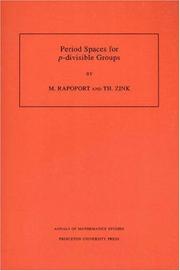
ISBN: 0691027811 1400882605 9780691027814 Year: 1996 Volume: 141 Publisher: Princeton (N.J.): Princeton university press
Abstract | Keywords | Export | Availability | Bookmark
 Loading...
Loading...Choose an application
- Reference Manager
- EndNote
- RefWorks (Direct export to RefWorks)
In this monograph p-adic period domains are associated to arbitrary reductive groups. Using the concept of rigid-analytic period maps the relation of p-adic period domains to moduli space of p-divisible groups is investigated. In addition, non-archimedean uniformization theorems for general Shimura varieties are established. The exposition includes background material on Grothendieck's "mysterious functor" (Fontaine theory), on moduli problems of p-divisible groups, on rigid analytic spaces, and on the theory of Shimura varieties, as well as an exposition of some aspects of Drinfelds' original construction. In addition, the material is illustrated throughout the book with numerous examples.
p-adic groups --- p-divisible groups --- Moduli theory --- 512.7 --- Theory of moduli --- Analytic spaces --- Functions of several complex variables --- Geometry, Algebraic --- Groups, p-divisible --- Group schemes (Mathematics) --- Groups, p-adic --- Group theory --- Algebraic geometry. Commutative rings and algebras --- 512.7 Algebraic geometry. Commutative rings and algebras --- p-divisible groups. --- Moduli theory. --- p-adic groups. --- Abelian variety. --- Addition. --- Alexander Grothendieck. --- Algebraic closure. --- Algebraic number field. --- Algebraic space. --- Algebraically closed field. --- Artinian ring. --- Automorphism. --- Base change. --- Basis (linear algebra). --- Big O notation. --- Bilinear form. --- Canonical map. --- Cohomology. --- Cokernel. --- Commutative algebra. --- Commutative ring. --- Complex multiplication. --- Conjecture. --- Covering space. --- Degenerate bilinear form. --- Diagram (category theory). --- Dimension (vector space). --- Dimension. --- Duality (mathematics). --- Elementary function. --- Epimorphism. --- Equation. --- Existential quantification. --- Fiber bundle. --- Field of fractions. --- Finite field. --- Formal scheme. --- Functor. --- Galois group. --- General linear group. --- Geometric invariant theory. --- Hensel's lemma. --- Homomorphism. --- Initial and terminal objects. --- Inner automorphism. --- Integral domain. --- Irreducible component. --- Isogeny. --- Isomorphism class. --- Linear algebra. --- Linear algebraic group. --- Local ring. --- Local system. --- Mathematical induction. --- Maximal ideal. --- Maximal torus. --- Module (mathematics). --- Moduli space. --- Monomorphism. --- Morita equivalence. --- Morphism. --- Multiplicative group. --- Noetherian ring. --- Open set. --- Orthogonal basis. --- Orthogonal complement. --- Orthonormal basis. --- P-adic number. --- Parity (mathematics). --- Period mapping. --- Prime element. --- Prime number. --- Projective line. --- Projective space. --- Quaternion algebra. --- Reductive group. --- Residue field. --- Rigid analytic space. --- Semisimple algebra. --- Sheaf (mathematics). --- Shimura variety. --- Special case. --- Subalgebra. --- Subgroup. --- Subset. --- Summation. --- Supersingular elliptic curve. --- Support (mathematics). --- Surjective function. --- Symmetric bilinear form. --- Symmetric space. --- Tate module. --- Tensor algebra. --- Tensor product. --- Theorem. --- Topological ring. --- Topology. --- Torsor (algebraic geometry). --- Uniformization theorem. --- Uniformization. --- Unitary group. --- Weil group. --- Zariski topology.
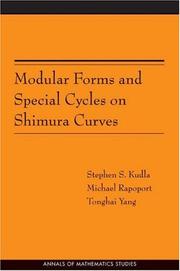
ISBN: 1299401023 1400837162 0691125511 0691125503 9781400837168 9780691125503 9780691125510 9781299401020 Year: 2006 Publisher: Princeton, NJ
Abstract | Keywords | Export | Availability | Bookmark
 Loading...
Loading...Choose an application
- Reference Manager
- EndNote
- RefWorks (Direct export to RefWorks)
Modular Forms and Special Cycles on Shimura Curves is a thorough study of the generating functions constructed from special cycles, both divisors and zero-cycles, on the arithmetic surface "M" attached to a Shimura curve "M" over the field of rational numbers. These generating functions are shown to be the q-expansions of modular forms and Siegel modular forms of genus two respectively, valued in the Gillet-Soulé arithmetic Chow groups of "M". The two types of generating functions are related via an arithmetic inner product formula. In addition, an analogue of the classical Siegel-Weil formula identifies the generating function for zero-cycles as the central derivative of a Siegel Eisenstein series. As an application, an arithmetic analogue of the Shimura-Waldspurger correspondence is constructed, carrying holomorphic cusp forms of weight 3/2 to classes in the Mordell-Weil group of "M". In certain cases, the nonvanishing of this correspondence is related to the central derivative of the standard L-function for a modular form of weight 2. These results depend on a novel mixture of modular forms and arithmetic geometry and should provide a paradigm for further investigations. The proofs involve a wide range of techniques, including arithmetic intersection theory, the arithmetic adjunction formula, representation densities of quadratic forms, deformation theory of p-divisible groups, p-adic uniformization, the Weil representation, the local and global theta correspondence, and the doubling integral representation of L-functions.
Arithmetical algebraic geometry. --- Shimura varieties. --- Varieties, Shimura --- Algebraic geometry, Arithmetical --- Arithmetic algebraic geometry --- Diophantine geometry --- Geometry, Arithmetical algebraic --- Geometry, Diophantine --- Arithmetical algebraic geometry --- Number theory --- Abelian group. --- Addition. --- Adjunction formula. --- Algebraic number theory. --- Arakelov theory. --- Arithmetic. --- Automorphism. --- Bijection. --- Borel subgroup. --- Calculation. --- Chow group. --- Coefficient. --- Cohomology. --- Combinatorics. --- Compact Riemann surface. --- Complex multiplication. --- Complex number. --- Cup product. --- Deformation theory. --- Derivative. --- Dimension. --- Disjoint union. --- Divisor. --- Dual pair. --- Eigenfunction. --- Eigenvalues and eigenvectors. --- Eisenstein series. --- Elliptic curve. --- Endomorphism. --- Equation. --- Explicit formulae (L-function). --- Fields Institute. --- Formal group. --- Fourier series. --- Fundamental matrix (linear differential equation). --- Galois group. --- Generating function. --- Green's function. --- Group action. --- Induced representation. --- Intersection (set theory). --- Intersection number. --- Irreducible component. --- Isomorphism class. --- L-function. --- Laurent series. --- Level structure. --- Line bundle. --- Local ring. --- Mathematical sciences. --- Mathematics. --- Metaplectic group. --- Modular curve. --- Modular form. --- Modularity (networks). --- Moduli space. --- Multiple integral. --- Number theory. --- Numerical integration. --- Orbifold. --- Orthogonal complement. --- P-adic number. --- Pairing. --- Prime factor. --- Prime number. --- Pullback (category theory). --- Pullback (differential geometry). --- Pullback. --- Quadratic form. --- Quadratic residue. --- Quantity. --- Quaternion algebra. --- Quaternion. --- Quotient stack. --- Rational number. --- Real number. --- Residue field. --- Riemann zeta function. --- Ring of integers. --- SL2(R). --- Scientific notation. --- Shimura variety. --- Siegel Eisenstein series. --- Siegel modular form. --- Special case. --- Standard L-function. --- Subgroup. --- Subset. --- Summation. --- Tensor product. --- Test vector. --- Theorem. --- Three-dimensional space (mathematics). --- Topology. --- Trace (linear algebra). --- Triangular matrix. --- Two-dimensional space. --- Uniformization. --- Valuative criterion. --- Whittaker function.
Book
ISBN: 0691197938 Year: 2019 Publisher: Princeton, NJ : Princeton University Press,
Abstract | Keywords | Export | Availability | Bookmark
 Loading...
Loading...Choose an application
- Reference Manager
- EndNote
- RefWorks (Direct export to RefWorks)
This book studies the interplay between the geometry and topology of locally symmetric spaces, and the arithmetic aspects of the special values of L-functions.The authors study the cohomology of locally symmetric spaces for GL(N) where the cohomology groups are with coefficients in a local system attached to a finite-dimensional algebraic representation of GL(N). The image of the global cohomology in the cohomology of the Borel-Serre boundary is called Eisenstein cohomology, since at a transcendental level the cohomology classes may be described in terms of Eisenstein series and induced representations. However, because the groups are sheaf-theoretically defined, one can control their rationality and even integrality properties. A celebrated theorem by Langlands describes the constant term of an Eisenstein series in terms of automorphic L-functions. A cohomological interpretation of this theorem in terms of maps in Eisenstein cohomology allows the authors to study the rationality properties of the special values of Rankin-Selberg L-functions for GL(n) x GL(m), where n + m = N. The authors carry through the entire program with an eye toward generalizations.This book should be of interest to advanced graduate students and researchers interested in number theory, automorphic forms, representation theory, and the cohomology of arithmetic groups.
Shimura varieties. --- Cohomology operations. --- Number theory. --- Arithmetic groups. --- L-functions. --- Functions, L --- -Number theory --- Group theory --- Number study --- Numbers, Theory of --- Algebra --- Operations (Algebraic topology) --- Algebraic topology --- Varieties, Shimura --- Arithmetical algebraic geometry --- Addition. --- Adele ring. --- Algebraic group. --- Algebraic number theory. --- Arithmetic group. --- Automorphic form. --- Base change. --- Basis (linear algebra). --- Bearing (navigation). --- Borel subgroup. --- Calculation. --- Category of groups. --- Coefficient. --- Cohomology. --- Combination. --- Commutative ring. --- Compact group. --- Computation. --- Conjecture. --- Constant term. --- Corollary. --- Covering space. --- Critical value. --- Diagram (category theory). --- Dimension. --- Dirichlet character. --- Discrete series representation. --- Discrete spectrum. --- Eigenvalues and eigenvectors. --- Eisenstein series. --- Elaboration. --- Embedding. --- Euler product. --- Field extension. --- Field of fractions. --- Free module. --- Freydoon Shahidi. --- Function field. --- Functor. --- Galois group. --- Ground field. --- Group (mathematics). --- Group scheme. --- Harish-Chandra. --- Hecke L-function. --- Hecke character. --- Hecke operator. --- Hereditary property. --- Induced representation. --- Irreducible representation. --- K0. --- L-function. --- Langlands dual group. --- Level structure. --- Lie algebra cohomology. --- Lie algebra. --- Lie group. --- Linear combination. --- Linear map. --- Local system. --- Maximal torus. --- Modular form. --- Modular symbol. --- Module (mathematics). --- Monograph. --- N0. --- National Science Foundation. --- Natural number. --- Natural transformation. --- Nilradical. --- Permutation. --- Prime number. --- Quantity. --- Rational number. --- Reductive group. --- Requirement. --- Ring of integers. --- Root of unity. --- SL2(R). --- Scalar (physics). --- Sheaf (mathematics). --- Special case. --- Spectral sequence. --- Standard L-function. --- Subgroup. --- Subset. --- Summation. --- Tensor product. --- Theorem. --- Theory. --- Triangular matrix. --- Triviality (mathematics). --- Two-dimensional space. --- Unitary group. --- Vector space. --- W0. --- Weyl group.
| Listing 1 - 10 of 16 | << page >> |
Sort by
|

 Search
Search Feedback
Feedback About UniCat
About UniCat  Help
Help News
News